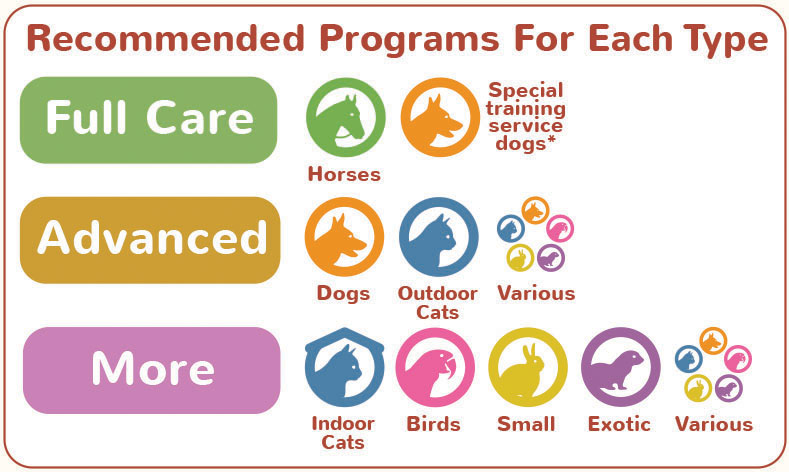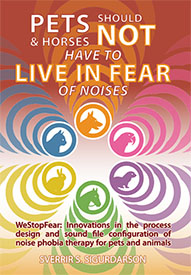Prevalence of noise phobias:
In 2013, Blackwell et al. conducted a research study to determine the prevalence of noise phobias in pet dogs. Almost half of the owners in the study reported that their dog showed at least one behavioral sign typical of fear when exposed to noises. An estimated of 29% of pet dogs show signs of anxiety-related behaviors (Denenberg et al., 2013), and 17% to 49% of all dogs have been estimated to demonstrate an aversion to noise (Blackwell et al., 2013).
Pathophysiology:
Physiological signs of a stress response, such as elevated cortisol, have been identified in dogs showing behavioral responses to noises (Hydbring-Sandberg et al., 2004). In many species, a physiological stress response occurs following exposure to a fear or anxiety-provoking stimulus. If anxious or fearful animals produce a stress response to many day-to-day stimuli, it follows that they may also live in a state of chronic physiological stress. Stressor activates the hypothalamic–pituitary–adrenal (HPA) system and increases the levels of cortisol in the blood stream. This leads to a series of adverse health effects like cardiovascular disease, immune disturbances, altered endocrine responses, obesity, insulin resistance and nervous system disorders. A study conducted by Dreschel in 2010 demonstrated that the stress associated with fear and anxiety can adversely affect health and lifespan of animals.
Current treatments:
Psychoactive drugs, including benzodiazepines, azapirones, antidepressants and selective serotonin reuptake inhibitors, are commonly prescribed in the treatment of fear and anxiety disorders in animals (Overall, 2013; Landsberg et al., 2013).
Fluoxetine and clomipramine are the only drugs licensed for anxiety treatment in dogs, however, these drugs can take a month or longer to achieve their full therapeutic effects and some owners are hesitant or unwilling to use these medications because of the potential for side effects or personal bias against psychotropic drug use (Landsberg, 2015). There are also various nutritional supplements marketed for behavior therapy, but very few have demonstrated any evidence of efficacy.
Advantages of the WeStopFear Method:
Prevent Fear(*) is based on the methods of desensitization and habituation, in which the stress-causing sounds are played with a gradual increase of volume in order for the animal to get used to these sounds. Unlike treatment with antidepressants and anxiolytics, this treatment is completely safe and there are no adverse health effects. Desensitization and habituation methods have been widely studied (Watts, 1971; Watts, 1979 & Lader, 1968) and are proven to be effective in the management of behavioral problems in animals.
Stephanie Flansburg-Cruz, veterinary and biology student, USA, July 2015.
* (At the time when this piece was written, the system was called Prevent Fear, but since then the name was changed to WeStopFear).
References:
Blackwell, E. J., John, W.S. Bradshaw, R. A. (2013). Fear responses to noises in domestic dogs: Prevalence, risk factors and co-occurrence with other fear related behavior. Applied Animal Behaviour Science
Overall, K.L., Dunham, A.E., Frank, D. (2001). Frequency of nonspecific clinical signs in dogs with separation anxiety, thunderstorm phobia, and noise phobia, alone or in combination. J. Am. Vet. Med. Assoc. 219, 467-73.
Landsberg, W. Hunthausen, L. Ackerman. (2013). Behavior Problems of the Dog and Cat (3rd 453 Ed.) Saunders Elsevier, Edinburgh, UK, pp. 139-149, 181-186.
Denenberg, S., Landsberg, G.M. (2008). Effect of dog-appeasing pheromones on anxiety and fear in puppies during training and on long-term socialization. J. Am. Vet. Med. Assoc. 233, 1874-1882
Dreschel, N.A., 2010. The effects of fear and anxiety on health and lifespan in pet dogs. Appl. Anim. Behav. Sci. 125, 157–162.
Lader, M. H., & Mathews, A. M. (1968). A physiological model of phobic anxiety and desensitization. Behaviour Research and Therapy, 6(4), 411-421.
Watts, F. N. (1979). Habituation model of systematic desensitization.Psychological Bulletin, 86(3), 627.
Watts, F. (1971). Desensitization as an habituation phenomenon: I. Stimulus intensity as determinant of the effects of stimulus lengths. Behaviour Research and Therapy. Volume 9, Issue 3, August 1971, Pages 209–217
Choose your pet type or horse solution introduction:
Dogs, outdoor cats, indoor cats, horses, pet birds, small mammals, exotic pets, and households with various types of pets.
(Small mammals include rabbits, guinea pigs and hamsters. Exotic pets include chinchilla, degu, fancy mice, fancy rats, fennec fox, ferret, gerbils, hedgehog, sugarglider and pot-bellied pig. Various types of pets are any pet types combination excluding horses.)

Front Pages Links
Types Solutions
Programs
Overview
Walk through screencast video
Sounds and videos
Try the 5 steps therapy sounds players
Sounds in programs (most types)
Sounds in Solutions for Horses
Sounds in Solutions for Outdoor Cats
Explore the 5 step video therapy
Further Information
Various information from around the web
Short comparison of WeStopFear and conventional process
What is noise phobia or fear of noises?
Conventional Noise Phobia Therapy
Comparing solutions in the market
A new standard practice for pets and horses?
The book
 The book "Pets and Horses Should Not Have To Live In Fear Of Noises", written by the innovator behind WeStopFear and the Simple Secure Steps, is available on Amazon.com as Print version or Kindle version.
The book "Pets and Horses Should Not Have To Live In Fear Of Noises", written by the innovator behind WeStopFear and the Simple Secure Steps, is available on Amazon.com as Print version or Kindle version.
Chapter: About animal types, fear of sounds, and noise phobia (page 23)
Chapter: Is this new method the best method available? (page 147)
The Story: Why and how WeStopFear was developed (page 160)
About the author and developer (page 189)
Merch and designs
The merch collections and DuFauna designs are designed by the innovator behind WeStopFear and the Simple Secure Steps.

